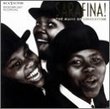| All Artists: Antonio Vivaldi, Bela Drahos, Nicolaus Esterhazy Sinfonia Title: Vivaldi: Bassoon Concertos 3 Members Wishing: 0 Total Copies: 0 Label: Naxos Original Release Date: 1/1/2006 Re-Release Date: 6/20/2006 Genre: Classical Styles: Forms & Genres, Concertos, Historical Periods, Baroque (c.1600-1750), Instruments, Reeds & Winds, Symphonies Number of Discs: 1 SwapaCD Credits: 1 UPC: 747313255627 |
Search - Antonio Vivaldi, Bela Drahos, Nicolaus Esterhazy Sinfonia :: Vivaldi: Bassoon Concertos 3
 | Antonio Vivaldi, Bela Drahos, Nicolaus Esterhazy Sinfonia Vivaldi: Bassoon Concertos 3 Genre: Classical |
Larger Image |
CD DetailsSimilar CDs |
CD ReviewsTerrific! Already looking forward to volume four Russ | Richmond, VA | 07/30/2006 (5 out of 5 stars) "If you haven't already acquired the first two volumes of this series, you are missing out. These are charming works, and the playing by bassoon virtuoso Tamas Benkocs is fantastic. Antonio Vivaldi (1678-1741) composed nearly 500 concertos. More than half of these are for violin, while the remaining concertos are scored for a variety instruments. One of the mysteries about Vivaldi concerns why he left 39 bassoon concertos, which is more than the number of concertos Vivaldi left for any other solo instrument, save the violin. If the bassoon concertos were written for a particular virtuoso, the identity of that person is not known to us today. Nevertheless, Vivaldi understood the technical capabilities of the instrument well, and makes dual use of the bassoon, with lyrical tenor lines contrasted against bass note accents. On this release we are presented with two minor key concertos (RV 495, 500) and four major key concertos (RV 474, 483, 502, 472). The outer movements of the concertos are a display of virtuosity, while the aria second movements are intensely lyrical. The concerto that stands out here is RV 483 in E flat major, with its blazingly fast opening movement. The precise tonguing here really has to be heard to be believed. Another interesting concerto is the RV 472 in C major, with its tricky third movement in which the sixteenth note laden solo part gives Benkocs the opportunity to showcase his ability to jump between the instrument's tenor and bass range and to contrast between legato and staccato sixteenth note runs. Also notable are the lovely minor key concertos, but of course, all of the concertos here are great. After all, this is Vivaldi. It should be noted that there is a competing set of bassoon concertos on the ASV label (full price) featuring Daniel Smith; however the Naxos series is definitely recommended above that one. First, and most important, Smith's bassoon playing is a very awkward and clumsy compared to Benkocs' superb rendition. To be direct, Benkocs' technique, especially his tonguing, is far superior to Smith's. Further, Smith's technique is such that the clicking of the bassoon keys is often audible, which is rather annoying, especially in the middle movements. Second, Naxos' sound is far more clear and transparent compared to the somewhat fuzzy sound on ASV. Also, the ensemble, especially the continuo, is presented more forwardly on the ASV recording, and often covers up the solo part (probably not what Vivaldi intended). This may not be a bad thing for the ASV recording though, as this is the one thing it has going for it. The ensemble playing on the ASV label is a bit more characteristic, especially the continuo player who takes far more liberties with the part in comparison to the player on the Naxos label. This type of thing may not appeal to those who prefer a strict reading of the continuo part, but I actually prefer this characteristic playing a bit more. In summary, this is a fantastic release and is highly recommended to those who may be looking to acquire something other than another set of Vivaldi's violin concertos. 53:20" This Fine Series Continues J Scott Morrison | Middlebury VT, USA | 07/15/2006 (5 out of 5 stars) "I gave a rave review to the first in this series of recordings by Hungarian bassoon virtuoso Tamás Benkócs of Vivaldi's thirty-nine bassoon concerti. You can guess that I am similarly impressed with this third issue in the series. It contains six of the concerti -- RV 495 in G minor, 474 in C major, 483 in E flat major, 502 in B flat major, 472 in C major, and 500 in A minor, in that order -- and is of uniformly high quality. I need add little about Benkócz's abilities, but I was particularly struck by his amazingly virtuosic rapid-fire repeated notes in the opening Presto of R 483. It fair takes your breath away. He is not just a virtuosic showman; he excels in the arioso middle movements of these three-movement concerti. All the accompaniments are for string orchestra, again the Nicolaus Esterházy Sinfonia under Béla Drahos who, I've just learned, formed the orchestra specifically to record for Naxos, which he did in the label's early complete set of Beethoven and Haydn symphonies as well as a quite creditable 'Fidelio.'
You will not be disappointed with this issue. By my calculation there should be another three or four volumes in this series before Benkócs and Drahos can move on to, say, the bassoon concerti of Mozart, Weber and Hummel. Scott Morrison" |


